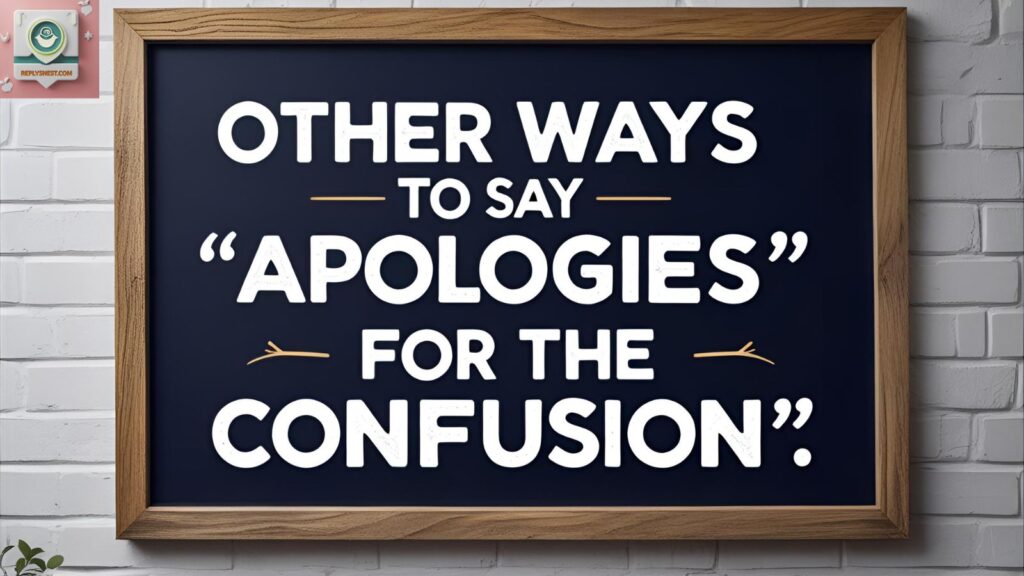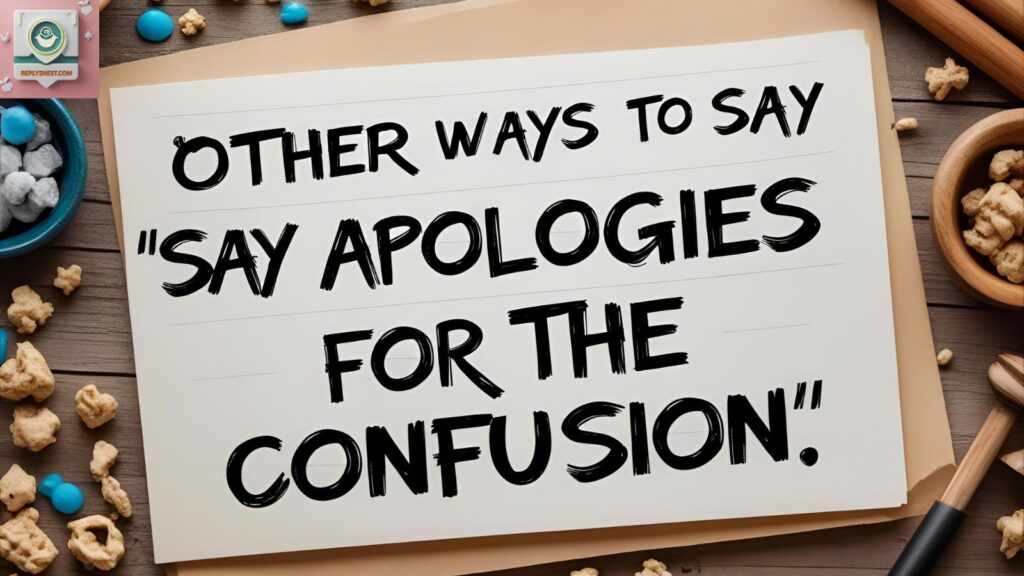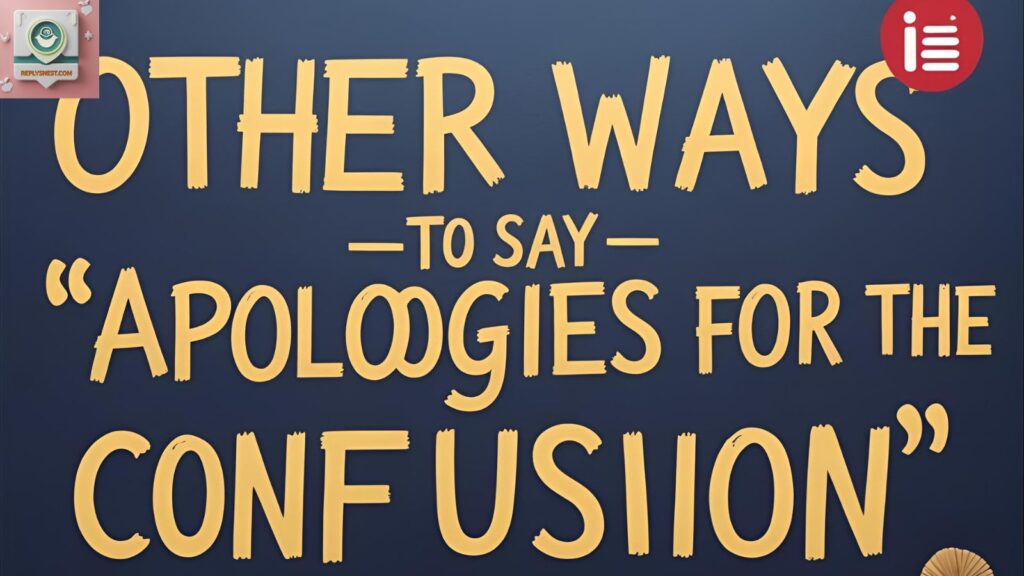In this article, we’ll explore 30 compassionate, clear, and human-centered ways to express that same sentiment without sounding robotic or overly formal. Whether you’re emailing a colleague, texting a friend, or replying in a business meeting, these variations will help you navigate communication with grace, humility, and professionalism.
In today’s fast-paced world, emails and messages are often sent in a rush, which leads to misunderstanding, confusion, or even incomplete thoughts. I remember once, in a professional email, I mistakenly provided the wrong info to a client about a parking space. My correction came too late, and it caused real inconvenience.
I knew a simple “sorry” wasn’t enough. So instead of saying, “apologies for the confusion,” I rephrased it into something more polite and sincere, like “I regret the mix-up and take full responsibility for the mistake.” This type of communication shows remorse, takes ownership, and keeps the tone considerate and respectful especially in professional settings.
When dealing with unclear or wrong statements, it’s important to amend or revise them quickly. People value when you’re thoughtful enough to clarify your message without sounding harsh, formal, or overly defensive.
You could say, “Let me update and clarify my earlier point,” or “I didn’t mean to offend you; I simply communicated that poorly.” These kinds of responses are more than just alternatives; they are ways to show grace, avoid damage, and maintain understanding. Whether it’s a flirty text that got misunderstood or a professional email, choosing the proper words can turn a potential difficulty into an opportunity to navigate the situation with clarity and ease.
1. I’m sorry if things weren’t clear earlier
A simple, kind way to acknowledge misunderstanding without placing blame.
- Best Use: When you realize a message you sent wasn’t understood properly.
- Not To Use: If the confusion was entirely on the other person’s side and clarity was already given.
- Other Ways To Say: “Sorry for the lack of clarity,” “Hope I can clarify now.”
- Example: “I’m sorry if things weren’t clear earlier let me break it down differently.”
Read More: Other Ways to Ask Someone “Where They Work”
2. Sorry about that mix-up!

This is friendly, light, and perfect for casual settings.
- Best Use: Informal communication between coworkers or friends.
- Not To Use: In formal apology emails or corporate settings.
- Other Ways To Say: “Oops, that got jumbled my bad!”
- Example: “Sorry about that mix-up! I totally see where things got crossed.”
3. Thanks for your patience let’s clear this up

Warm, appreciative, and focused on resolution.
- Best Use: When dealing with delays or misunderstandings.
- Not To Use: If no confusion occurred at all.
- Other Ways To Say: “Appreciate you sticking with me here’s the clarification.”
- Example: “Thanks for your patience, let’s clear this up together.”
4. I see how that might’ve been confusing

Empathetic and validating.
- Best Use: When you want to show you understand the other person’s perspective.
- Not To Use: If you’re trying to avoid responsibility.
- Other Ways To Say: “I get how that could’ve been unclear.”
- Example: “I see how that might’ve been confusing, let me rephrase it.”
5. Let me rephrase that for clarity
Professional and solution-focused.
- Best Use: Emails, reports, or any situation that calls for a reset.
- Not To Use: Casual chats or when the tone needs to be more apologetic.
- Other Ways To Say: “Let me clarify that point,” “Allow me to put it differently.”
- Example: “Let me rephrase that for clarity the deadline is actually Friday.”
6. I understand how that came across my apologies
Shows self-awareness and responsibility.
- Best Use: When you suspect miscommunication has affected someone’s feelings.
- Not To Use: If the confusion wasn’t about tone or delivery.
- Other Ways To Say: “I didn’t mean it that way sorry for the misunderstanding.”
- Example: “I understand how that came across my apologies for any confusion.”
7. That could’ve been clearer let me try again
Approachable and humble.
- Best Use: In any explanation where your wording fell short.
- Not To Use: When speaking to someone who expects formal phrasing.
- Other Ways To Say: “Let me say that another way.”
- Example: “That could’ve been clearer, let me try again with simpler terms.”
8. Totally get why that didn’t make sense
Relatable and friendly tone.
- Best Use: Team chats, collaboration tools, internal discussions.
- Not To Use: Customer service replies or formal client communication.
- Other Ways To Say: “I see where the wires got crossed.”
- Example: “Totally get why that didn’t make sense my bad for the confusion!”
9. Let’s reset and walk through it again
Calm and solution-oriented.
- Best Use: When leading discussions or solving problems.
- Not To Use: For short written communication.
- Other Ways To Say: “Let’s go over it step-by-step again.”
- Example: “Let’s reset and walk through it again. I want to make sure it’s all clear now.”
10. Sorry if that caused any misunderstanding
Straightforward, honest, and gentle.
- Best Use: Emails or verbal follow-ups.
- Not To Use: Overused in rapid-fire apologies; loses meaning.
- Other Ways To Say: “Hope that didn’t confuse things too much.”
- Example: “Sorry if that caused any misunderstanding, here’s the full context.”
11. Thanks for flagging that
Grateful and professional.
- Best Use: When someone catches a mistake or misunderstanding.
- Not To Use: If no one pointed anything out.
- Other Ways To Say: “Appreciate you bringing that up.”
- Example: “Thanks for flagging that I’ve updated the info accordingly.”
12. That wasn’t my intention, let me clarify
Softens the confusion with a touch of empathy.
- Best Use: Customer service, relationships, professional feedback.
- Not To Use: When the message was factually wrong.
- Other Ways To Say: “Let me explain what I actually meant.”
- Example: “That wasn’t my intention, let me clarify so we’re on the same page.”
13. I misspoke here’s the right info
Honest and direct.
- Best Use: When you’ve given the wrong data, date, or detail.
- Not To Use: If you weren’t the one providing information.
- Other Ways To Say: “Correction: it should’ve been…”
- Example: “I misspoke the meeting’s on Wednesday, not Thursday.”
14. Sorry, that might’ve sounded confusing
Polite and self-aware.
- Best Use: When your tone or wording was off.
- Not To Use: If the confusion came from their end, not yours.
- Other Ways To Say: “Let me make that more clear.”
- Example: “Sorry, that might’ve sounded confusing what I meant was…”
15. That’s on me here’s the fix
Casual ownership with a solution.
- Best Use: Slack messages, informal work conversations.
- Not To Use: High-stakes professional writing.
- Other Ways To Say: “My fault, let me correct it.”
- Example: “That’s on me I meant Q3 results, not Q2.”
16. I should’ve explained that better
Humility meets clarity.
- Best Use: When you overlooked the importance of context.
- Not To Use: In legal or formal documents.
- Other Ways To Say: “Let me give a better breakdown.”
- Example: “I should’ve explained that better thanks for catching it!”
17. Let me make it right
Simple, sincere, and action-driven.
- Best Use: When your words or actions caused real confusion.
- Not To Use: If it was a minor or negligible issue.
- Other Ways To Say: “Let me fix what went wrong.”
- Example: “Let me make it right, here’s the revised document.”
18. Just to clarify…
Gentle and proactive.
- Best Use: When jumping into a follow-up without sounding defensive.
- Not To Use: If you haven’t apologized first for bigger mix-ups.
- Other Ways To Say: “To avoid any confusion…”
- Example: “Just to clarify the pricing includes support too.”
19. Sorry, that wasn’t as clear as I intended
Acknowledges good intent while admitting room for improvement.
- Best Use: When your goal was misunderstood.
- Not To Use: If you didn’t provide any info to begin with.
- Other Ways To Say: “Let me give it another shot.”
- Example: “Sorry, that wasn’t as clear as I intended. Here’s a better explanation.”
20. Let’s make sure we’re on the same page
Proactive and partnership-oriented.
- Best Use: Collaborations, planning meetings, or finalizing decisions.
- Not To Use: As a standalone apology without context.
- Other Ways To Say: “Can I confirm our understanding?”
- Example: “Let’s make sure we’re on the same page before moving forward.”
21. My explanation could’ve been better thanks for your patience
Grateful and growth-minded.
- Best Use: Educational, tutorial-based or coaching conversations.
- Not To Use: Brief, high-pressure email threads.
- Other Ways To Say: “I’ll try a simpler way to explain it.”
- Example: “My explanation could’ve been better thanks for your patience while I walk you through it again.”
22. Totally understandable if that was confusing
Validating and kind.
- Best Use: Soothing a frustrated team member or client.
- Not To Use: When the confusion wasn’t significant.
- Other Ways To Say: “You’re not the only one confused, I can see why.”
- Example: “Totally understandable if that was confusing let’s take another look together.”
23. I didn’t communicate that well, let me fix it
Admitting fault with initiative.
- Best Use: Feedback situations or internal reviews.
- Not To Use: When blame isn’t on your side.
- Other Ways To Say: “Let me fix the communication gap.”
- Example: “I didn’t communicate that well, let me fix it by sending an updated summary.”
24. That’s definitely a bit murky let’s clear it up
Playful yet helpful.
- Best Use: Creative teams, collaborative discussions.
- Not To Use: Serious corporate correspondence.
- Other Ways To Say: “Let’s clean up the confusion.”
- Example: “That’s definitely a bit murky, let’s clear it up before the client sees it.”
25. Let’s sort that out together
Inclusive and team-focused.
- Best Use: Conflict resolution or teamwork hiccups.
- Not To Use: When a more formal apology is expected.
- Other Ways To Say: “We can work through this.”
- Example: “Let’s sort that out together. I want to make sure you’re comfortable with the details.”
Conclusion: Speak With Clarity, Connect With Kindness
Misunderstandings are a natural part of life. What matters most is how we handle them. From emails to Zoom calls, from team chats to heartfelt one-on-ones, being able to say “Apologies for the confusion” in fresh, meaningful ways strengthens your relationships and builds trust.
Over the years working in communications, I’ve learned that how you say something often matters more than what you say. Being warm, clear, and human turns mistakes into moments of connection. Whether you’re fixing a typo or explaining a complex idea, your words carry weight. Make them thoughtful.
Use these alternatives not just as phrases, but as invitations to better understanding. And remember: clarity is kind and kindness, always, is powerful.



